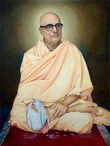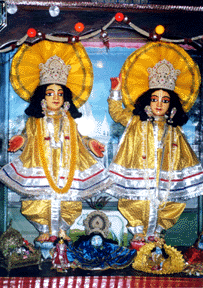![[Home Page]](../grfx/bml_logo.gif)

Srila Bhakti Dayita Madhava
Goswami Maharaja Page
Excerpts from the Holy Biography of His Divine Grace Nityalila-pravista Om Visnupada Paramahamsa 108 Sri Srila Bhakti Dayita Madhava Gosvami Maharaja
 Srila Bhakti Dayita Madhava
Gosvami Maharaja is the Spiritual Preceptor of His Divine Grace
Sri Srila Bhakti Ballabh Tirtha Maharaja, who related these excerpts
originally in Bengali. A full English edition of this biography
will be available from GOKUL in the near future.
Srila Bhakti Dayita Madhava
Gosvami Maharaja is the Spiritual Preceptor of His Divine Grace
Sri Srila Bhakti Ballabh Tirtha Maharaja, who related these excerpts
originally in Bengali. A full English edition of this biography
will be available from GOKUL in the near future.In this text, the title "Srila Gurudeva" refers to Srila Bhakti Dayita Madhava Gosvami Maharaja.
Photo: Their Divine Lordships Sri Sri Gaur-Nitai as They appear at Imli-tala, Vrindavana, India.
In 1954, before it became the practice to hold the previously mentioned religious conventions, Srila Gurudeva would read and analyze the Srimad Bhagavatam in various temples. At that time, He was staying in Kanya Balika Vidyalaya, near Jalandhar railway station in Fantanganj. He was accompanied by His spiritual colleagues and disciples, Sri Dinabandhu Brahmacari (Srimad Bhakti Sambandha Parvata Maharaja), Sri Narayana dasa Brahmacari (Srimad Bhakti Prasada Puri Maharaja), Sri Radha Krsna Garga (Srimad Bhakti Sarvasva Niskincana Maharaja), Sri Krsna Ballabh Brahmacari (Srimad Bhakti Ballabh Tirtha Maharaja) and others. Every morning, Srila Gurudeva would recite scripture at Sri Nohadiya Mandir, where the holy deities of Sri Sita-Rama, Sri Hanuman and the Siva-linga resided. For seekers of the Ultimate Truth, the answer to the following question is of the utmost importance. After listening to Srila Gurudeva for some time, an elderly lady asked a question in the Punjabi language. Sri Narayana dasa Brahamacari, who originally came from Punjab, acted as interpreter, for although Srila Gurudeva knew Hindi, He was not fluently conversant in Punjabi. This highly relevant question was as follows.
For the last fifty years without fail, the elderly lady had been coming to the temple, taking darsana of the holy deities, attending arati ceremonies, circumambulating the temple, singing kirtana glorifying Sri Hari and listening to the Bhagavad-gita, Srimad Bhagavatam, Ramayana, etc. whenever the opportunity arose. Now she was old and unfortunately, despite all this, not a grain of devotion or love for Sita-Rama had sprouted in her heart. Instead, the pull of attraction for her children and grandchildren had increased. If love for Bhagavan had not grown under these circumstances, then what could be the use of such practices and disciplines?
Srila Gurudeva was very pleased to hear this particular question. He announced to the gathering that since everyone should be there to hear the reply, He would therefore give it the following day.
The next day, before speaking on the scriptures, Srila Gurudeva asked the elderly lady whether or not she had ever requested anyone to explain the true identity of Sri Sita-Rama, her own self, the world and her relationship with Sri Sita-Rama. Had she, instead, attended the temple as a matter of course without feeling the need to be inquisitive?
"Without awareness of any relationship, love for Bhagavan cannot be experienced. It is the knowledge of relationships that gives birth to love. Even in our day to day lives, whenever someone desires to know our identity, we rattle off a string of relationships such as: 'I am the child of that mother or father,' 'I am the mother or father of that child,' 'I am the husband or wife of that person,' etc. Carrying with us the concept that our identity is comprised of such mundane types of relationships, we visit the temple, view the deities, participate in Hari-kirtana, listen to Hari-katha and go through the motions of observing various religious practices. However, we find that these observances do not take us to Sri Hari, but instead, root us ever more firmly in our family/friend relationships. These works are punya, or dharma (actions performed for future merits). They are not bhakti, or devotion. The false ego drives man to fruitive activity. This petty ego must be discarded and the all-pervading 'I' of the self must be embraced. In our daily lives, whatever we do feeds this petty ego. For example, one thinks, 'This is my wife, my child,' etc. Even when we visit the temple, it is for the interest of this false self and for all that is seemingly connected with or related to it. We do not go to the temple for Sri Bhagavan. Thus, it is only natural that we display the tendency to follow the dictates of our ego, falsely thinking that therein lies our self-interest.
The day I realize that I belong to Sri Bhagavan, that all my relationships are with Sri Bhagavan, then my real self will become manifested, and spontaneously, all my actions will be for Sri Bhagavan and Sri Bhagavan alone. Identifying my interests with those of Sri Bhagavan, I will now surrender myself and all that belongs to that self to Sri Bhagavan. Only in that specific situation is love and devotion for Sri Bhagavan possible. The grace of the bonafide guru or preceptor will enable us to realize to whom we are actually related. Prior to this knowledge of relationship, it is not possible to have any idea of Sri Bhagavan. When we do not exert much effort to understand the nature of this relationship, our realization is understandably delayed. After establishing this relationship, we can start our sadhana (spiritual practices) and begin to understand our real needs. The scriptures of sanatana-dharma and all the wise sages have discussed three important points in great detail: 1. sambandha --the conditioned soul's relationship with the Supreme Lord, 2. abhidheya --the regulated activities for reviving one's relationship with the Supreme Lord and 3. prayojana --the ultimate goal of life to be attained by the conditioned soul, i.e., Krsna-prema, love of God.
In spiritual life then, the first step is toward sambandha-jnana --knowledge of relationships."
![[Home Page]](../grfx/bml_logo.gif)

Srila Bhakti Dayita Madhava
Goswami Maharaja Page